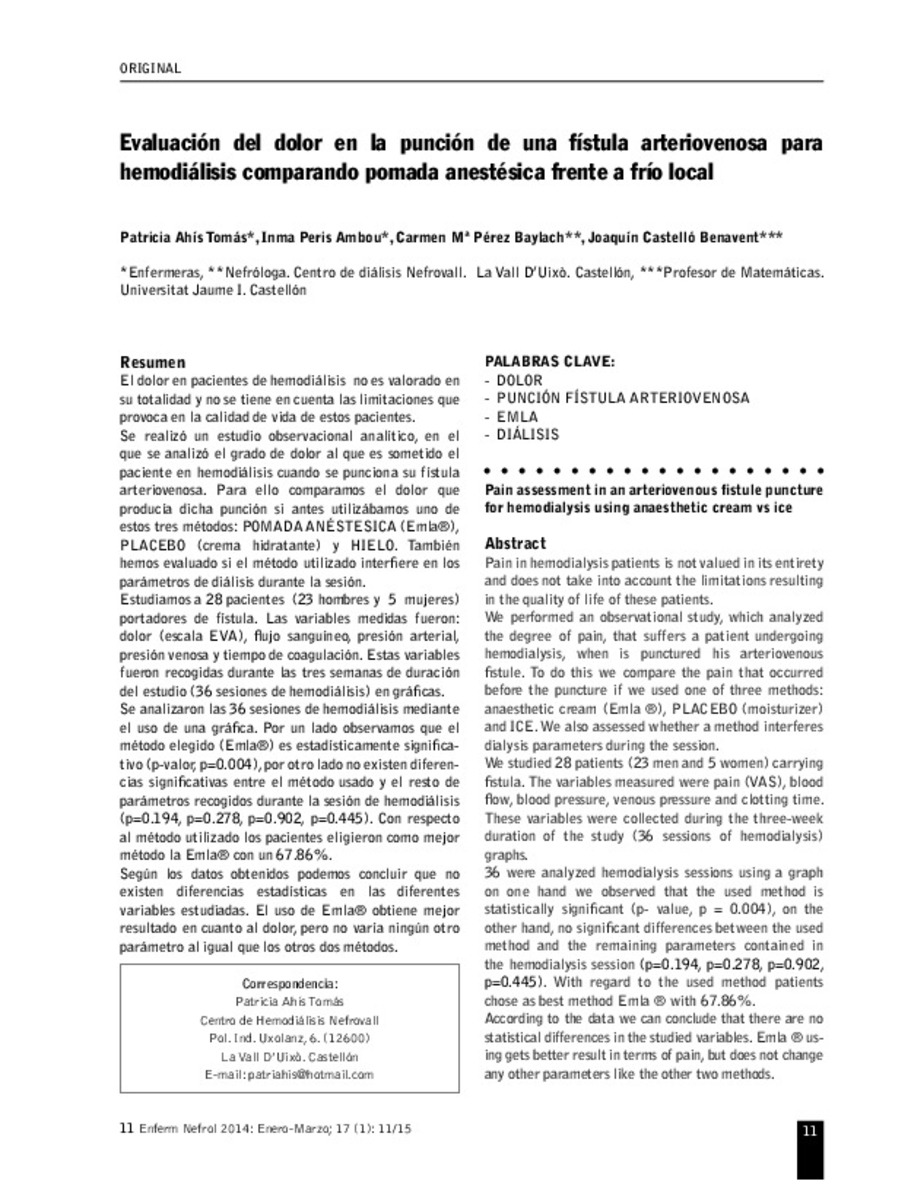| dc.contributor.author | Ahís Tomás, Patricia | |
| dc.contributor.author | Peris Ambou, Inma | |
| dc.contributor.author | Pérez Baylach, Carmen Mª | |
| dc.contributor.author | Castelló Benavent, Joaquín | |
| dc.date.accessioned | 2015-09-30T17:54:12Z | |
| dc.date.available | 2015-09-30T17:54:12Z | |
| dc.date.issued | 2014-03 | |
| dc.identifier.issn | 2254-2884 | |
| dc.identifier.issn | 2255-3517 | |
| dc.identifier.uri | http://hdl.handle.net/10234/134605 | |
| dc.description.abstract | El dolor en pacientes de hemodiálisis no es valorado en su totalidad y no se tiene en cuenta las limitaciones que provoca en la calidad de vida de estos pacientes. Se realizó un estudio observacional analítico, en el que se analizó el grado de dolor al que es sometido el paciente en hemodiálisis cuando se punciona su fístula arteriovenosa. Para ello comparamos el dolor que producía dicha punción si antes utilizábamos uno de estos tres métodos: POMADA ANÉSTESICA (Emla®), PLACEBO (crema hidratante) y HIELO. También hemos evaluado si el método utilizado interfiere en los parámetros de diálisis durante la sesión. Estudiamos a 28 pacientes (23 hombres y 5 mujeres) portadores de fístula. Las variables medidas fueron: dolor (escala EVA), flujo sanguíneo, presión arterial, presión venosa y tiempo de coagulación. Estas variables fueron recogidas durante las tres semanas de duración del estudio (36 sesiones de hemodiálisis) en gráficas. Se analizaron las 36 sesiones de hemodiálisis mediante el uso de una gráfica. Por un lado observamos que el método elegido (Emla®) es estadísticamente significativo (p-valor, p=0.004), por otro lado no existen diferencias significativas entre el método usado y el resto de parámetros recogidos durante la sesión de hemodiálisis (p=0.194, p=0.278, p=0.902, p=0.445). Con respecto al método utilizado los pacientes eligieron como mejor método la Emla® con un 67.86%. Según los datos obtenidos podemos concluir que no existen diferencias estadísticas en las diferentes variables estudiadas. El uso de Emla® obtiene mejor resultado en cuanto al dolor, pero no varía ningún otro parámetro al igual que los otros dos métodos. | ca_CA |
| dc.description.abstract | Pain in hemodialysis patients is not valued in its entirety and does not take into account the limitations resulting in the quality of life of these patients. We performed an observational study, which analyzed the degree of pain, that suffers a patient undergoing hemodialysis, when is punctured his arteriovenous fistule. To do this we compare the pain that occurred before the puncture if we used one of three methods: anaesthetic cream (Emla ®), PLACEBO (moisturizer) and ICE. We also assessed whether a method interferes dialysis parameters during the session. We studied 28 patients (23 men and 5 women) carrying fistula. The variables measured were pain (VAS), blood flow, blood pressure, venous pressure and clotting time. These variables were collected during the three-week duration of the study (36 sessions of hemodialysis) graphs. 36 were analyzed hemodialysis sessions using a graph on one hand we observed that the used method is statistically significant (p- value, p = 0.004), on the other hand, no significant differences between the used method and the remaining parameters contained in the hemodialysis session (p=0.194, p=0.278, p=0.902, p=0.445). With regard to the used method patients chose as best method Emla ® with 67.86%. According to the data we can conclude that there are no statistical differences in the studied variables. Emla ® using gets better result in terms of pain, but does not change any other parameters like the other two methods. | ca_CA |
| dc.format.extent | 5 p. | ca_CA |
| dc.format.mimetype | application/pdf | ca_CA |
| dc.language.iso | spa | ca_CA |
| dc.publisher | Sociedad Española de Enfermería Nefrológica SEDEN | ca_CA |
| dc.relation.isPartOf | Enfermería Nefrológica , 2014, vol. 17, núm. 1 | ca_CA |
| dc.rights | © 2015 Sociedad Española de Enfermería Nefrológica
Enfermería Nefrológica por Sociedad Española de Enfermería Nefrológica se distribuye bajo una Licencia Creative Commons Atribución-NoComercial 4.0 Internacional. | ca_CA |
| dc.rights | Attribution-NonCommercial 4.0 Spain | * |
| dc.rights.uri | http://creativecommons.org/licenses/by-nc/4.0/ | * |
| dc.subject | Dolor | ca_CA |
| dc.subject | Punción fístula arteriovenosa | ca_CA |
| dc.subject | Emla | ca_CA |
| dc.subject | Diálisis | ca_CA |
| dc.subject | Pain | ca_CA |
| dc.subject | Fistule needle arteriovenous | ca_CA |
| dc.subject | Emla | ca_CA |
| dc.subject | Dialysis | ca_CA |
| dc.title | Evaluación del dolor en la punción de una fístula arteriovenosa para hemodiálisis comparando pomada anestésica frente a frío local | ca_CA |
| dc.title.alternative | Pain assessment in an arteriovenous fistule puncture for hemodialysis using anaesthetic cream vs ice | ca_CA |
| dc.type | info:eu-repo/semantics/article | ca_CA |
| dc.identifier.doi | http://dx.doi.org/10.4321/S2254-28842014000100002 | |
| dc.rights.accessRights | info:eu-repo/semantics/openAccess | ca_CA |
| dc.relation.publisherVersion | http://www.revistaseden.org/anteriores.aspx | ca_CA |
| dc.type.version | info:eu-repo/semantics/publishedVersion | |








